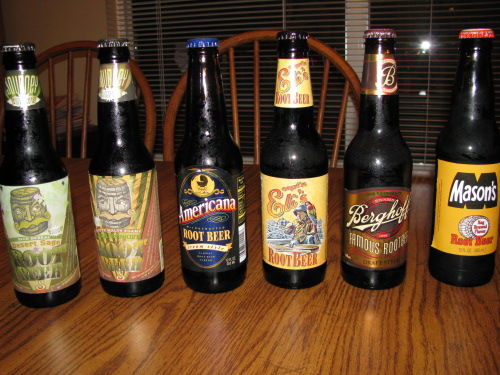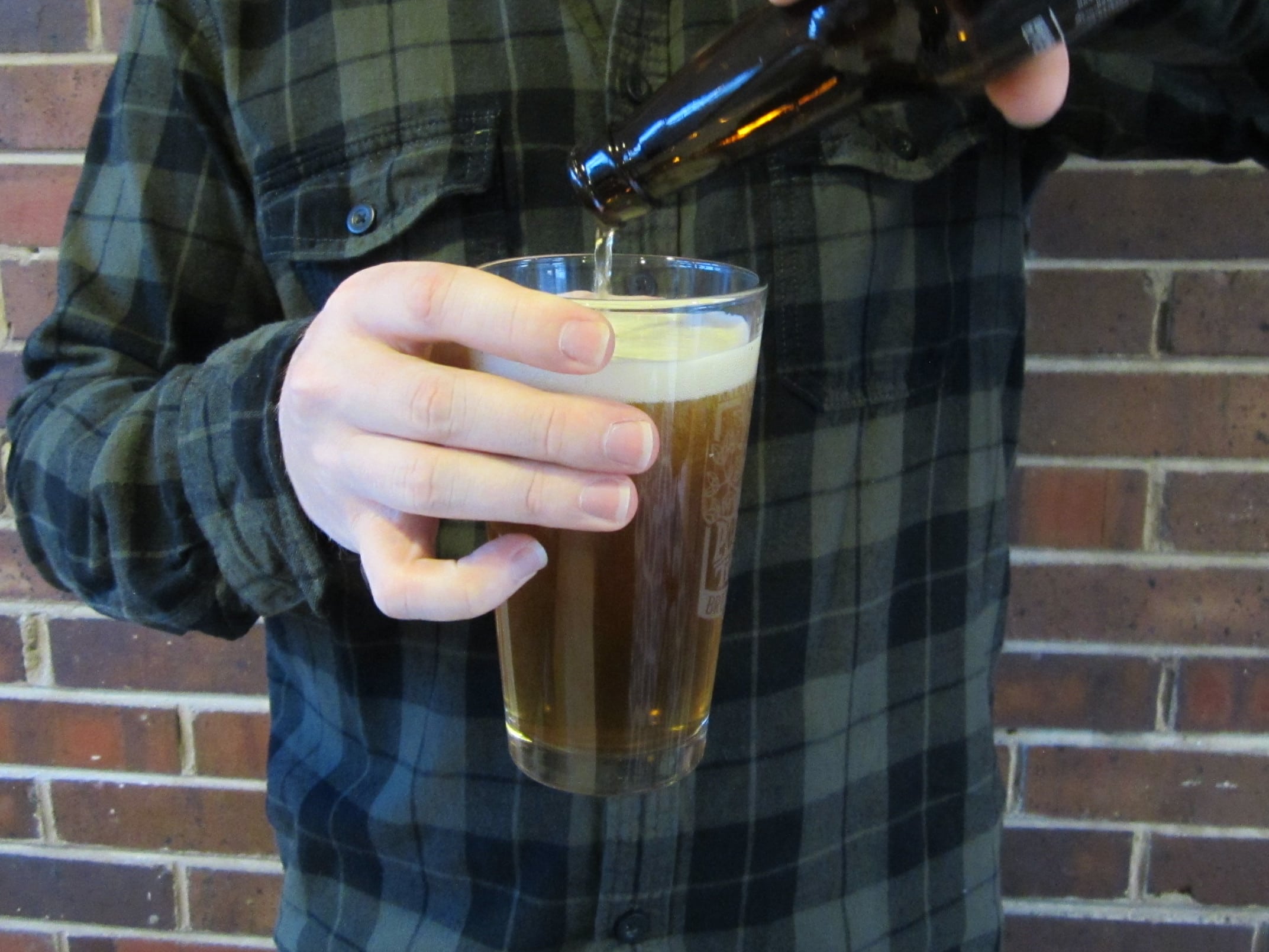
Everywhere you look these days, attention is being paid to craft beers — heavy, hoppy small batch brews made by independent companies with artisanal recipes, new combinations of ingredients, and unique flavor profiles.
Cheap, old school beers — the kind your dad used to drink while grilling some brats or watching the World Series — have come to be looked down upon by some as boring, bland, water-downed corporate swill — the “fast food” of brews.
While craft beers can be tasty, there still a place in a man’s fridge, and definitely his koozie, for cheap beer. Today I’ll talk about why the old school stuff should still be celebrated, and make 5 suggestions to enjoy (unironically) this summer.
Let’s see what your Pops knew all along.
A Very Brief History of “Cheap” Beer
When I talk about “cheap beer,” I’m talking about any domestic beer sold in large quantities, and made by Coors, Miller, or Anheuser-Busch (known as “the Big 3”). These three brewers sell the vast majority of beer in the US and their brands include: Coors and Coors Light, Budweiser and Bud Light, Busch, Natural Ice, Michelob, Miller High Life, Miller Lite, etc. Beyond those, these brewers also still manufacture a number of what would be called “nostalgia brands” like Hamm’s, Pabst Blue Ribbon, Rainier, etc.
The ironic thing about these brands is that while they’re today seen as mediocre budget beverages, 100 years ago, they were actually considered premium stuff, and priced accordingly
In the mid-1800s, most brewers were still making the heavy German lagers of yore, using only malted barley as the alcohol-producing grain. They were catering to a largely immigrant or first-generation market, so this made sense. Once the Midwest started to really come into its own, though, and step out from its immigrant roots, Americans wanted something different. In an industrial, fast-paced world, one couldn’t leisurely drink a heavy beer over a two-hour lunch. Businessmen needed something lighter that wouldn’t fill them up and would sit a little easier over the course of a busy day or evening.
And so brewers adapted (particularly those in the Midwest), and searched out other ingredients, like corn and rice, that might be used in the brewing process. From experimentation and innovation was born a uniquely American beer: the Bohemian lager — a style now technically known as “American adjunct lager” (because it uses “adjunct” ingredients besides just barley). Even though grains like corn and rice were more expensive at the time, making for a pricier beverage, the brew soon became a worldwide sensation, winning numerous accolades and awards. Pabst Blue Ribbon is in fact called such because it took the top prize at the 1893 World’s Fair in Chicago (though that’s a hotly debated and even litigated story).
Right from the start, a few titans of brewing — Frederick Pabst, Augustus Busch, Frederick Miller, Joseph Schlitz (recognize those last names?) — made their beer on an enormous scale and took over nearly the entire industry; even back then, the market was dominated by 3-4 big-time companies.
Over the last century, the once novel American lager has come to seem humdrum, a victim of its own success. And the Big 3’s monopoly of the beer biz is now viewed as stifling and constricting, if not a nefarious corporate conspiracy. The American consumer has thus gone looking for new tastes, and the craft beer industry has swelled to quench this thirst.
Yet while there’s certainly merit in the new (and yes, in many cases, improved), there’s also something to be said for the straightforward, non-fussy, comfortingly familiar, and wonderfully cheap.
Why We Should Still Celebrate the Cheap Beers
They’re easy drinkin’. As a style, Bohemian/American lager is effervescent, pale to pretty much clear in color, and slightly sweet because of the corn (and sometimes rice). They go down easy, sit a little lighter in the stomach, and don’t fill you up as much as other beers. They’re also lower alcohol by volume (ABV) than a lot of craft brews, which means you don’t have to worry about sitting in the backyard and throwing back a few brewskis with your friends.
They’re cheap. They’re not called cheap beers for nothing. While a sixer of craft beer here in Colorado is likely to cost me $8-$10, that same price point gets me a 12-pack of something like Miller High Life or Hamm’s. That’s a big difference, especially as years — and beers — go by.
They support a ton of American jobs. While the Big 3 companies are no longer independent or American-owned and have extremely complex structures for their brands and beer-making, they are still producing at the same large (often unionized) breweries they started at here in the States, and providing thousands of jobs across the country, and especially in their local markets. While it’s definitely nice to support independent businesses sometimes, it’s not like the big beer makers don’t also contribute to their respective communities.
They’re nostalgic. Cheap beer is very likely what your father or grandpa (and definitely your cool uncle) drank back in the day (and perhaps still drinks today). Dad gave you a sip now and then, and that taste is imprinted in your memory, or you can picture him doing work around the house with a specific beer in hand. Cheap beer is probably what you started drinking in college and a connection to it has stuck with ya all these years. While nostalgia alone isn’t a reason to choose one brew over another, it does add an intangible layer of enjoyment to drinking one.
5 Cheap Beers to Drink This Summer
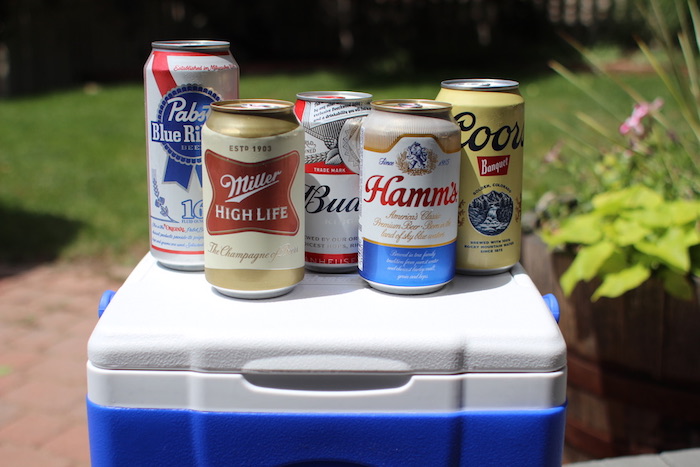
Recently I taste-tested a dozen or so brands of cheap beer, and very unscientifically suggest the following 5 (plus their light counterparts in a couple cases), based not solely on taste, but also availability, and other not-so-quantifiable factors (like nostalgia) as well.
My top picks, listed in no particular order, for post-lawn mowing relaxation, backyard BBQs, and grilling brats (Dad was right about that too), are:
Hamm’s
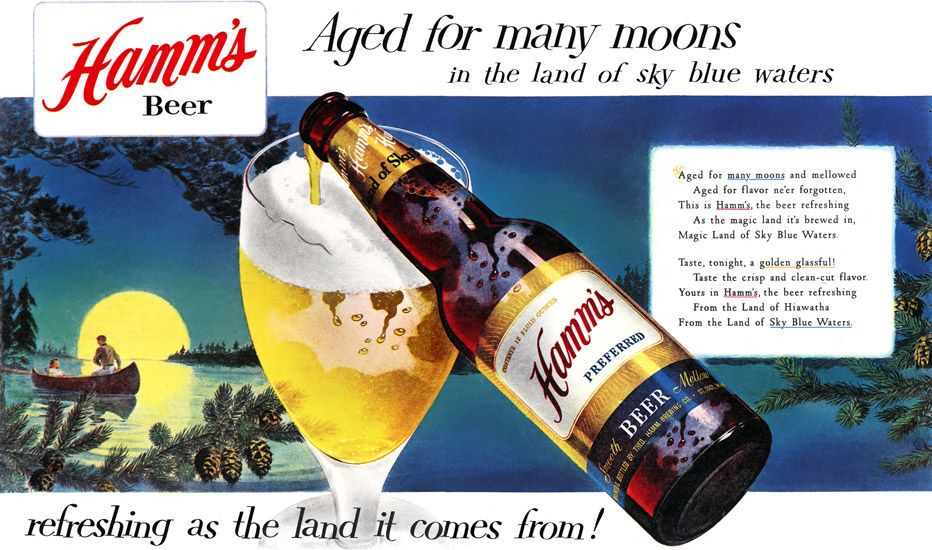
While Hamm’s started as more of a regional Minnesota brew before Prohibition, after the repeal, it took off as a national beer, even climbing to the top 5 in domestic sales in the ‘50s.
While currently made by Miller, it’s experiencing a bit of a resurgence, especially in the Midwest where it was originally brewed. Because of Miller’s huge distribution network, though, it can actually be found just about anywhere.
Not only is the vintage branding just cool, the flavor has a crisp sweetness that sets it apart from other domestic brews. It’s not necessarily as bubbly as other beers, but sometimes carbonation is used to mask a bland flavor, so that’s not a bad thing. The flavor here can actually come through, and it’s a decent one at that.
Pabst Blue Ribbon
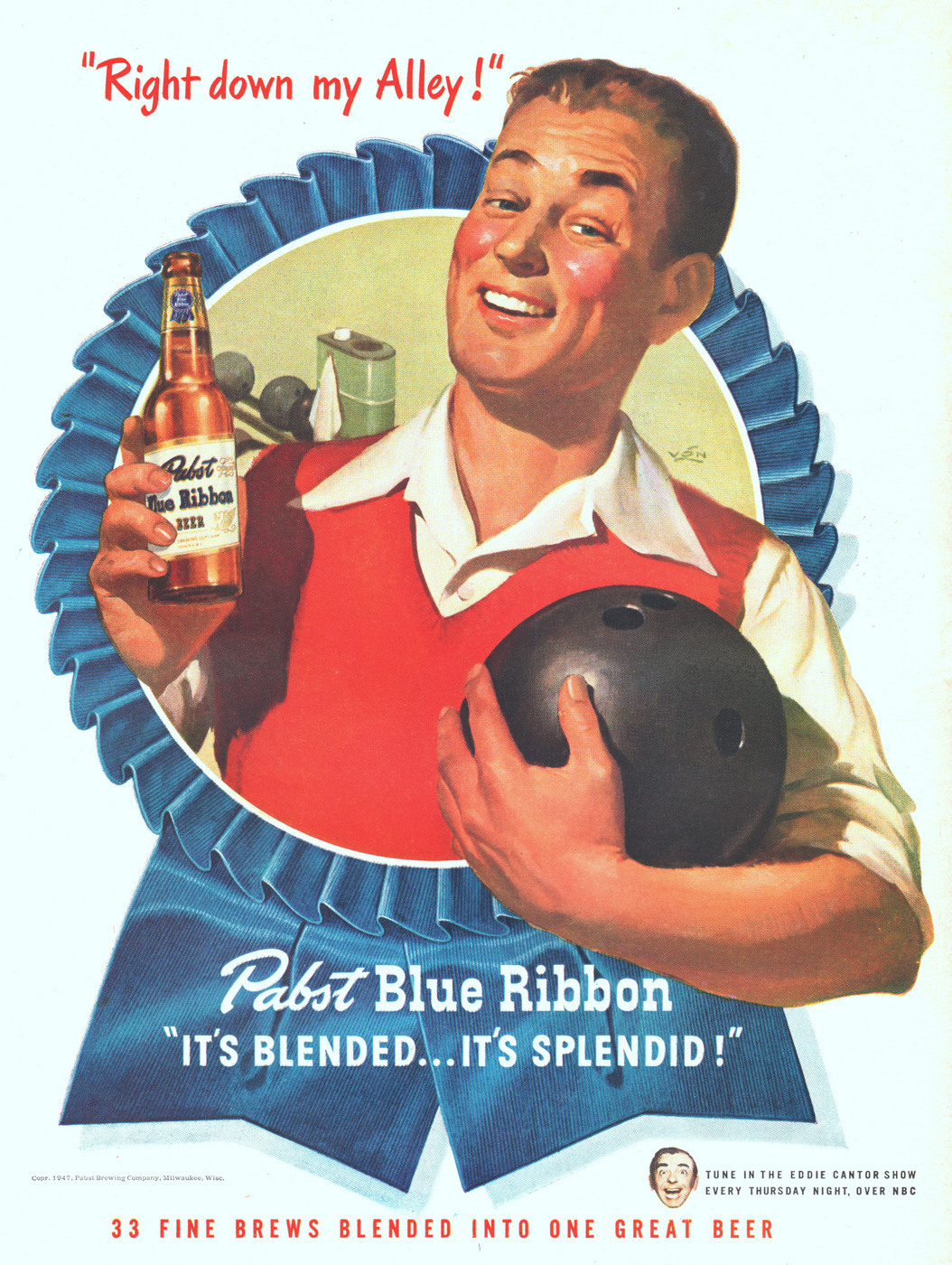
At one time, PBR was indeed made from a blend of 33 batches of beer (hence the “33 fine brews…” at the bottom). Nowadays it’s still made from a blend, but my research found it was now 12 batches into one.
To be honest, I don’t love the flavor of PBR, but it’s become the cheap beer of choice for hipsters and is thus available at a lot of trendy restaurants and bars for often just a couple bucks (compared to $7-$10 for a nice craft brew). In my research, it also tended to be the cheapest that actually tasted good enough to drink.
As noted briefly above, Pabst Blue Ribbon got its name from winning a hotly debated contest in 1893 that wasn’t even supposed to be a contest. The World’s Fair had a beer hall, and any brew that received over a certain score was supposed to earn a certificate of recognition. But Frederick Pabst and Augustus Busch turned it into an all-out competition between PBR and Budweiser, in which Pabst ultimately won out by less than a full point. From then on, Pabst has put the “Blue Ribbon” appellation on every can.
While it’s not bad (like some of the beers I tried), PBR seems to lack some of the stronger pure beer flavors you get from a few of the others on this list. It’s just a hair boring. That said, a 16oz can of this stuff hits the spot when sweatin’ outside and bagging up yard waste. It’s just dang refreshing.
Miller High Life + Miller Lite

Though the beers on this list aren’t ranked, Miller High Life was my overall favorite. The sweetness of the corn really comes through more than any of the others I tried, and it was balanced nicely with a highly carbonated mouthfeel which still allowed that flavor to really be tasted. Frederick Miller was right to market this brew as “The Champagne of Beers” when it debuted as a premium, foil-wrapped product in 1903.
And while light beers aren’t my own personal preference, the top 3 domestic brews by sales are indeed light beers. Miller Lite, being the first to really hit the popular market back in the ‘70s, was my favorite of all the lights I tried. Again, a little more sweetness than the other beers, but not in an overpowering way. It also happens to be AoM food expert Matt Moore’s go-to beer (he in fact only rarely drinks craft).
Budweiser + Bud Light

Budweiser, from its inception, has been marketed as the “King of Beers” because it was modeled after a beer called the “Beer of Kings” which was (and in fact still is) made in an old Czech brewery that dates all the way back to the 13th century. Bud Light and Budweiser account for almost a full quarter of all domestic beer sold in the US, and rank respectively as the number 1 and number 4 beers by sales. Bud Light alone in fact has almost a 19% market share, which is 50% more than the entire craft beer industry.
Whereas most of these domestic beers use corn (well, some liquid derivative of it) to give the beer flavor, Budweiser and Bud Light use rice as their adjunct ingredient. This gives it a decidedly different flavor than the others listed here. Rather than being sweet, it actually has a drier, more crisp finish that doesn’t linger in the mouth. While I prefer Budweiser to its light cousin, either beer is perfect for a cookout with friends or a day at the beach.
Coors

Here in Colorado, Coors is definitely the de facto cheap brew, and regional loyalty aside, its taste is right up there among my favorites.
The original, non-light beer is called Coors Banquet, and a 24oz can of this stuff is about as good as it gets on a hot summer day at the ballpark.
Interestingly, it was only available in 11 states until the mid-1970s, meaning it didn’t hit the national scene until much later than these other brews. Because of its exclusivity, it actually developed somewhat of a cult following before it became widely available. Eisenhower kept it aboard Air Force One, Gerald Ford served it every Thursday at the White House, and Paul Newman called it “the best domestic beer, bar none.”
Once it went big, though, it went really big, and Coors Light is now the #2 selling beer in the states. While I didn’t enjoy the light variety myself, most of my neighbors do, so pick your poison and enjoy it without shame.
Ultimately, there are no real definitive “bests” when it comes to cheap beer (or really any beer). You probably already have a favorite that you’re going to remain loyal to. And if you don’t, give these 5 a try, remember the long history of what was once considered the finest style of beer in all the land, and don’t be afraid to celebrate the enjoyment of easy, cheap refreshment.



